Assets are created on the AM Asset Maintenance form, which can be accessed by selecting the Financials option on the Financials Web Main Menu:
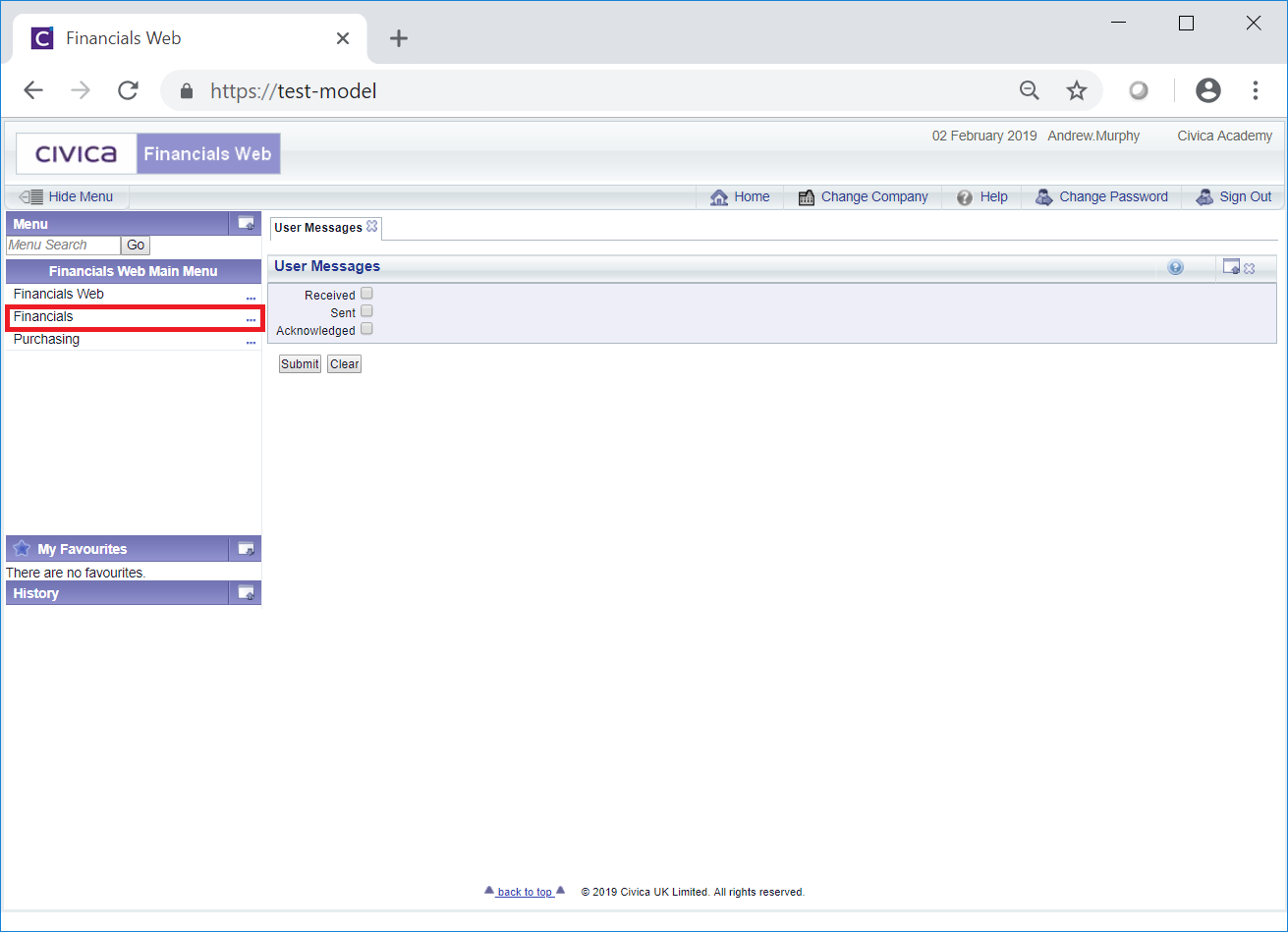
Then the Asset Management menu option:
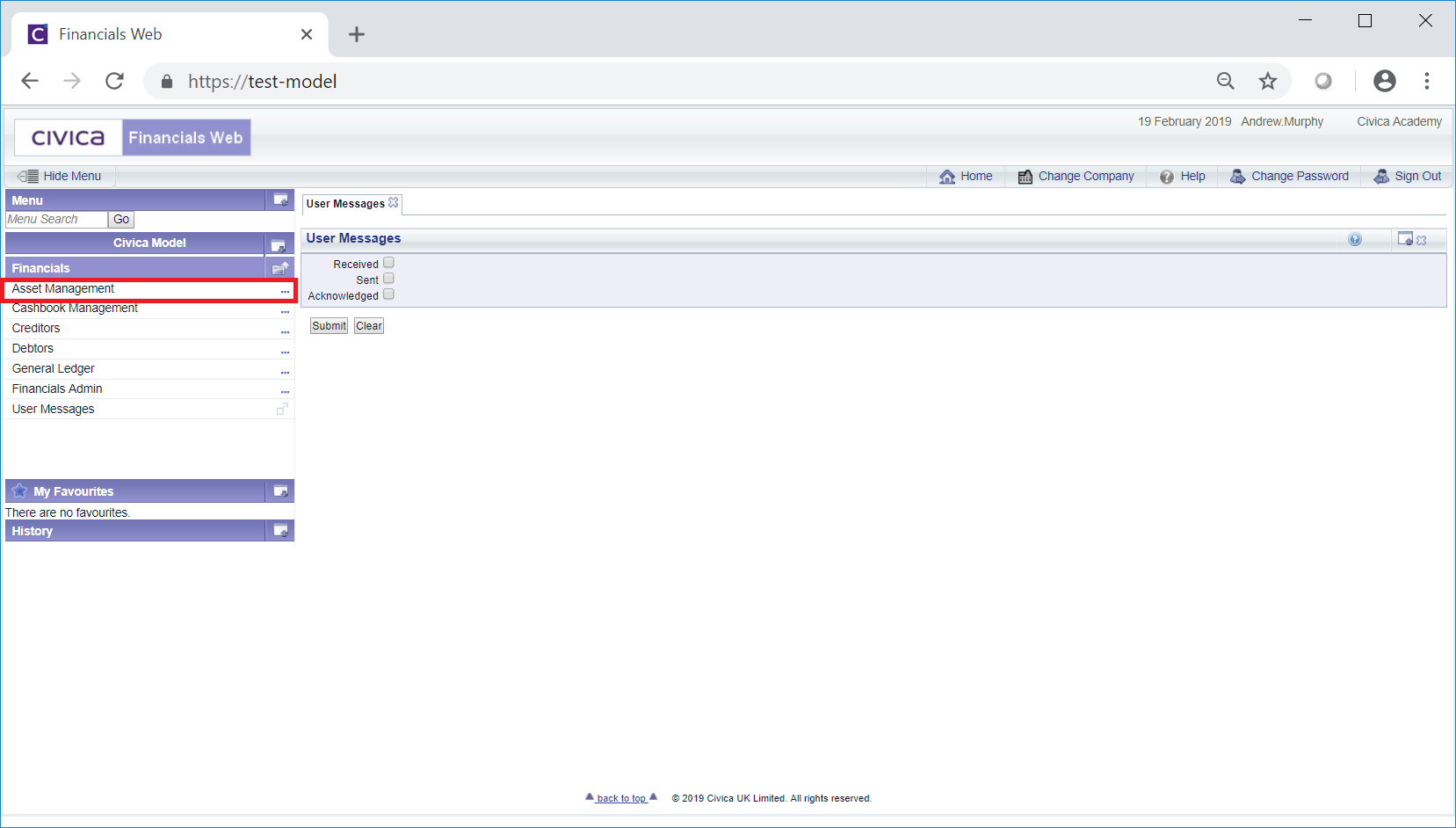
Then the AM Asset Maintenance menu option:
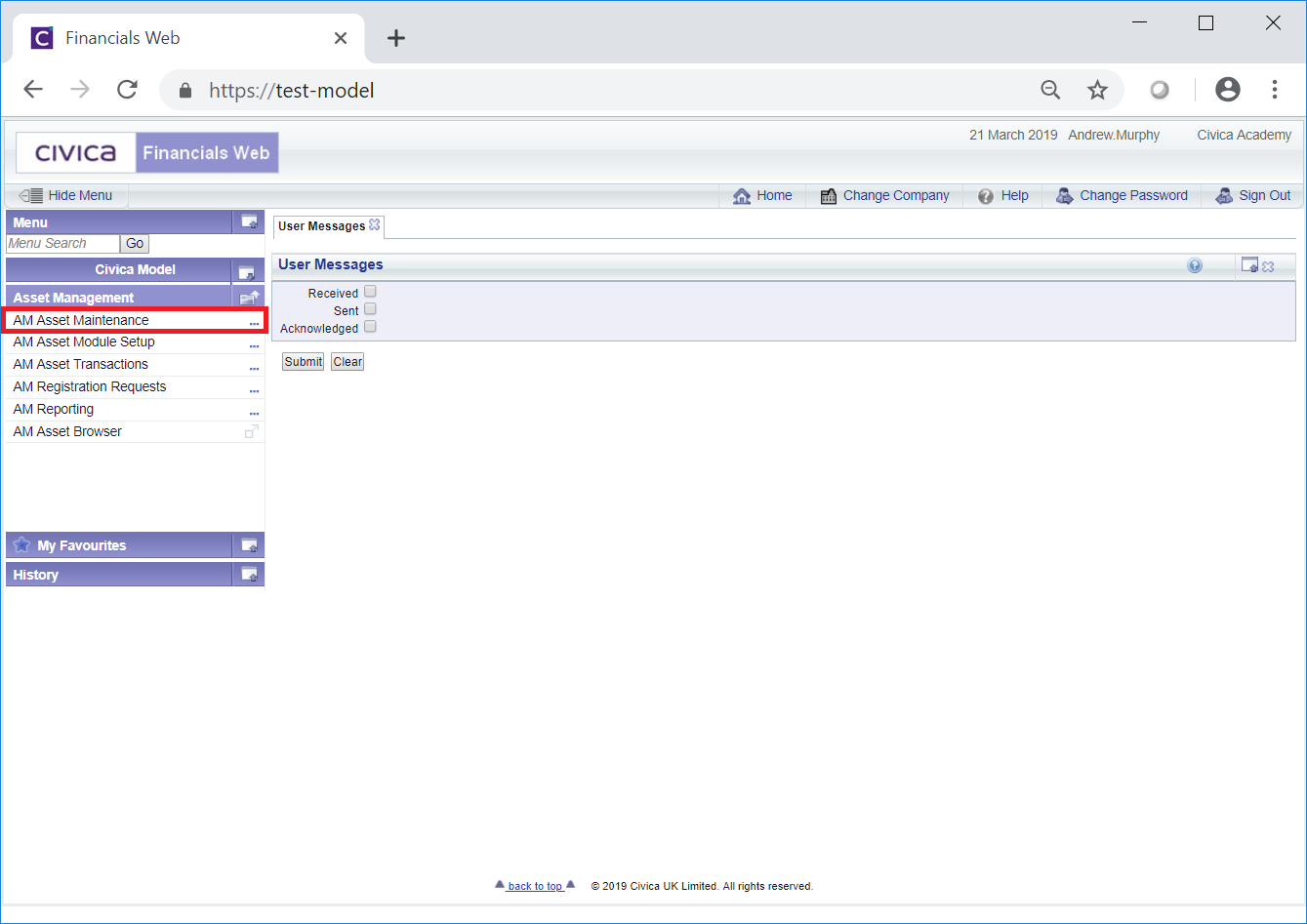
Then the AM Asset Maintenance menu option:
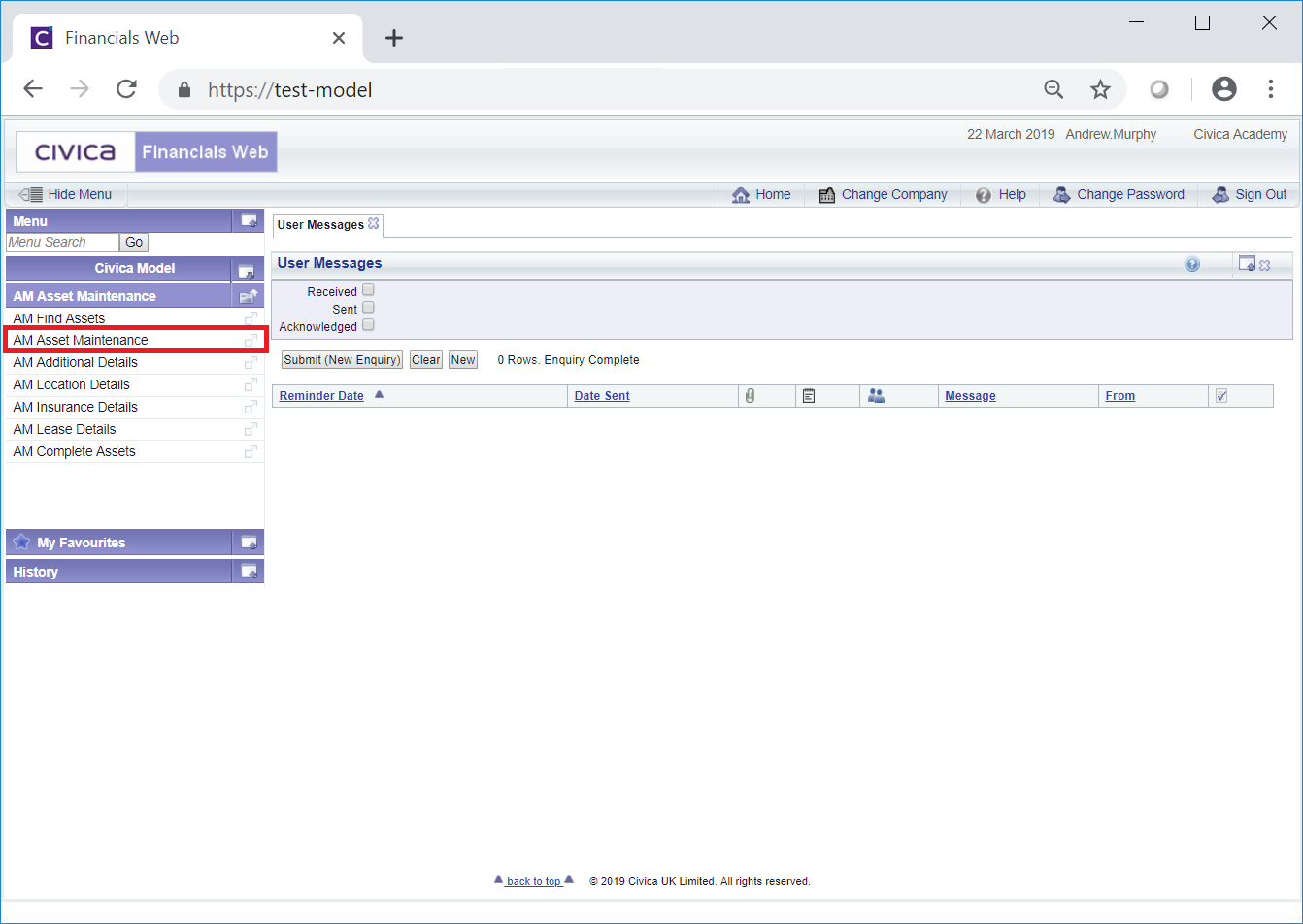
The AM Asset Maintenance form will then be displayed:
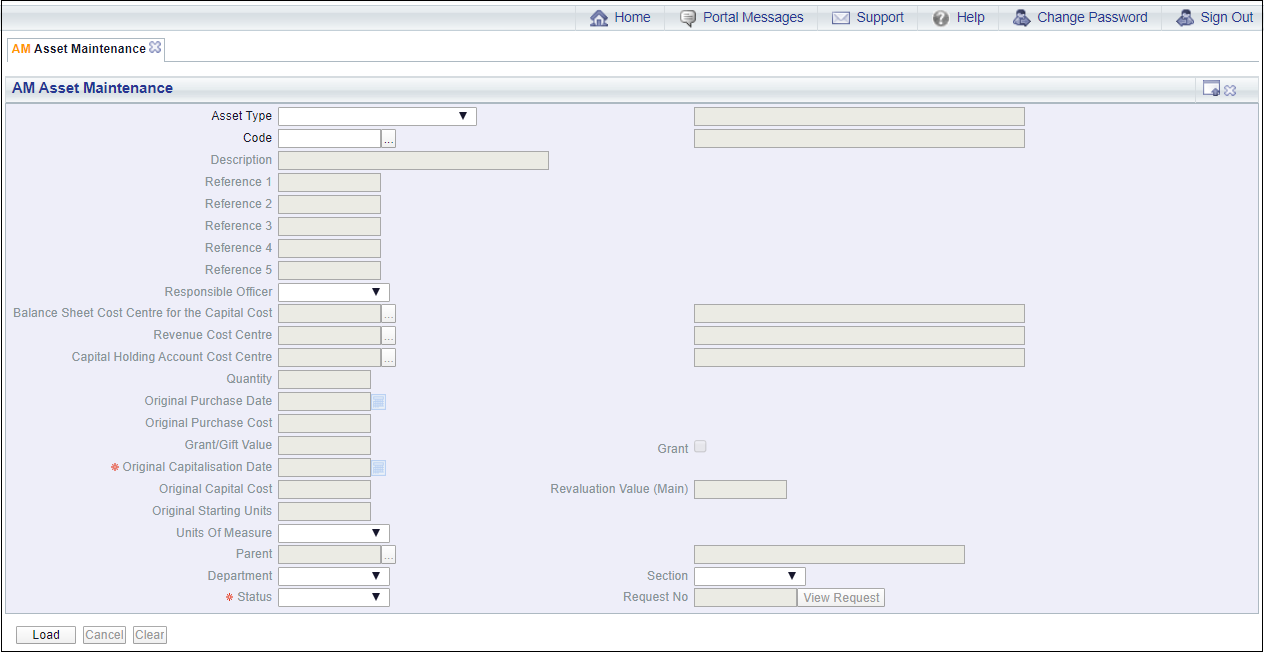
Select the relevant Asset Type for the new Asset from the Asset Type drop-down field. Once the form is loaded this will provide certain default information for the Asset. Asset Types are further detailed in the Asset Types section.
Select the  button.
button.
Further fields will then be displayed on the AM Asset Maintenance form:
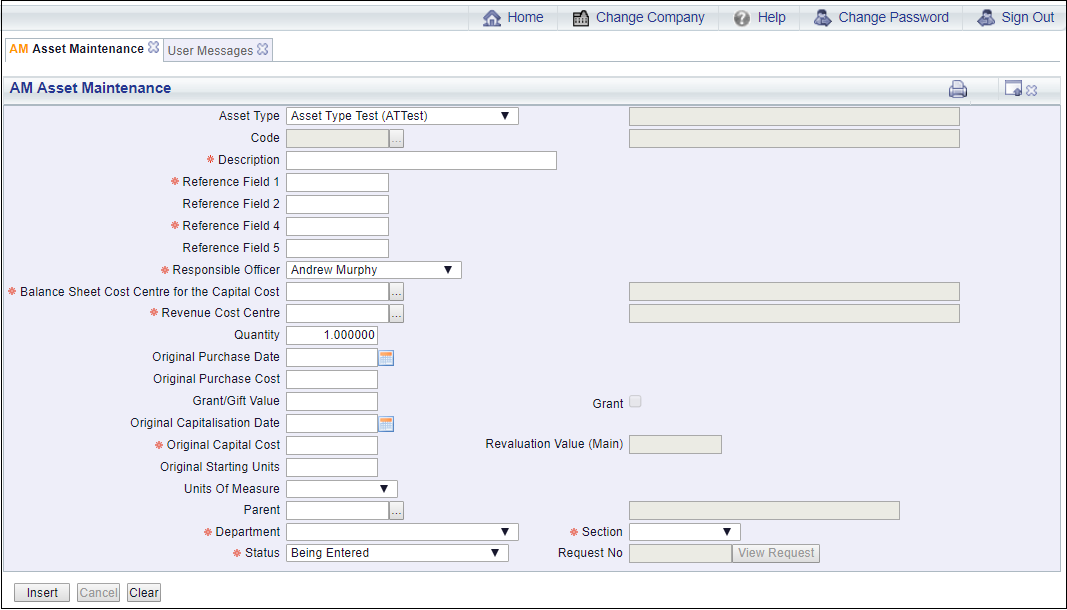
Please note: There may be fields displayed between the Description field and the Responsible Officer field:

These are User defined Reference fields that are defined by the Asset Type added to the Asset Type field, including the number of fields displayed (a maximum of 5), the name of the each field and whether they are mandatory or discretionary fields. Asset Types are further detailed in the Asset Types section.
Add the required details to these Reference fields as well as to the other fields and options, which are further detailed below (mandatory fields are notated with a red asterisk *):
- Description: Add a description for the Asset.
 : Clicking on this button will allow you to add an image of the Asset from your network.
: Clicking on this button will allow you to add an image of the Asset from your network.
An Upload Image pop-up box will open:
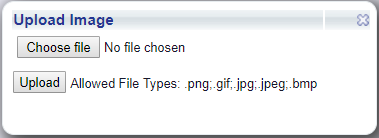
Click on the  button and select the required image from your network - the name of the mage will then be added next to the
button and select the required image from your network - the name of the mage will then be added next to the  button.
button.
Then click on the  button - the types of files that can be uploaded are listed next to the
button - the types of files that can be uploaded are listed next to the  button.
button.
- Responsible Officer: Where this field contains your User name, you are defined as a responsible officer for Assets. A different User can be selected from the drop-down options if required. Where the field is blank, select the relevant responsible officer from the drop-down list
- Balance Sheet for the Capital Cost: Add the General Ledger Cost Centre code to this field that will receive the relevant GL postings for the Balance Sheet.
Alternatively the required Cost Centre code can be searched for and selected by clicking on the Find Cost Centre button located to the right of this field,  . This will open the AM Find Balance Sheet Cost Centres for the Capital Cost form where the required Cost Centre can be searched for and once selected will be added to this field. This form is further detailed in the Find Balance Sheet Cost Centre section.
. This will open the AM Find Balance Sheet Cost Centres for the Capital Cost form where the required Cost Centre can be searched for and once selected will be added to this field. This form is further detailed in the Find Balance Sheet Cost Centre section.
You will note that the name of the Cost Centre added will appear in the adjacent field.
- Revenue Cost Centre: Add the General Ledger Cost Centre code to this field that is to receive the GL postings for the Revenue Accounts.
Alternatively the required Cost Centre code can be searched for and selected by clicking on the Find Cost Centre button located to the right of this field,  . This will open the AM Find Revenue Cost Centres form where the required Cost Centre can be searched for and once selected will be added to this field. This form is further detailed in the Find Revenue Cost Centre section.
. This will open the AM Find Revenue Cost Centres form where the required Cost Centre can be searched for and once selected will be added to this field. This form is further detailed in the Find Revenue Cost Centre section.
You will note that the name of the Cost Centre added will appear in the adjacent field.
- Quantity: This field can be used where Assets are grouped together, for example where a generic Asset is created for all Personal Computers at a specified location, a number can be added in this field for the number of Personal Computers included in the Asset. Where one is to be disposed, it can be split from the original Asset and then disposed. Splitting Assets is further detailed in the Split section and Disposals are further detailed in the Disposal section.
This field will default to 1 and can be changed if required.
- Original Purchase Date: A date that the Asset was purchased can be added to this field, if required, for information purposes.
- Original Purchase Cost: The cost of the Asset when purchased can be added to this field, if required, for information purposes.
- Grant/Gift Value: Where a grant or gift is associated with the Asset, the value of the grant or gift can be added to this field, if required.
- Grant: Ignore this option as it is not currently being used.
- Original Capitalisation Date: Add the original capitalisation date to this field. This will also be used to specify the default date on the Depreciation Start Date field on the AM Asset Maintenance (Insert Book) form, when an Asset Book is inserted on the Asset. This form is further detailed in the Insert Books section.
- Original Capital Cost: Add the original capitalisation cost to this field. This can be zero if required. This will be used as the default amount on the Capital Cost field on the AM Asset Maintenance (Insert Book) form, when an Asset Book is inserted on the Asset. This form is further detailed in the Insert Books section.
- Revaluation Value (Main): This field will be blank and you will not be able to changes it. This field will be populated with the amount in the Original Capital Cost field, detailed immediately above, when an Asset Book is inserted on the Asset. This form is further detailed in the Insert Books section.
- Original Starting Units: This field can be used to add the starting number of units for the Asset, for example where a vehicle is purchased with mileage of 10,000. Where the Depreciation Method is Units of Use, as defined in the Asset Type added to the Asset Type field, the amount in the Original Starting Units field will be used as the default amount in the Starting Units field on the AM Asset Maintenance (Insert Book) form when an Asset Book is inserted on the Asset. This form is further detailed in the Insert Books section.
- Units of Measure: This field can be used to record the Units of Measure for the amount added in the Original Starting Units field immediately above e,g. miles. If required select the relevant option from the drop-down list.
- Parent: This field can be used to link the Asset to a Parent Asset to show that it belongs to a hierarchy of Assets. If required add the code of the Parent Asset to this field.
Alternatively the required Asset code can be searched for and selected by clicking on the Find Asset button located to the right of this field,  . This will open the AM Find Asset Parents form where the required Asset can be searched for and once selected will be added to this field. This form is further detailed in the Find Asset Parent section.
. This will open the AM Find Asset Parents form where the required Asset can be searched for and once selected will be added to this field. This form is further detailed in the Find Asset Parent section.
If an Asset is added to the Parent field the description of the Asset will appear in the adjacent field.
- Department: Select the relevant Department for the Asset from this drop-down field.
- Section: Select the relevant Section for the Asset from this drop-down field - the options will be dependant on the Department added to the Department field, detailed immediately above.
- Status: This will be set to
 as you are entering the details for the Asset. You will not be able to change this field.
as you are entering the details for the Asset. You will not be able to change this field.
- Request No: This field will not be enabled but will be used where the Asset is created from an Asset Registration Request, which is further detailed in the Asset Registration Requests section.
The following buttons are also available at the bottom of the form:
 : Clicking on this button will clear all the fields, returning you to the original version of the form where you can create a new Asset or search for an existing one.
: Clicking on this button will clear all the fields, returning you to the original version of the form where you can create a new Asset or search for an existing one. : Clicking on this button will create the Asset. The fields detailed above will now appear in a Main tab and further further tabs will become available. Additional buttons will also appear at the bottom of the Main tab:
: Clicking on this button will create the Asset. The fields detailed above will now appear in a Main tab and further further tabs will become available. Additional buttons will also appear at the bottom of the Main tab:
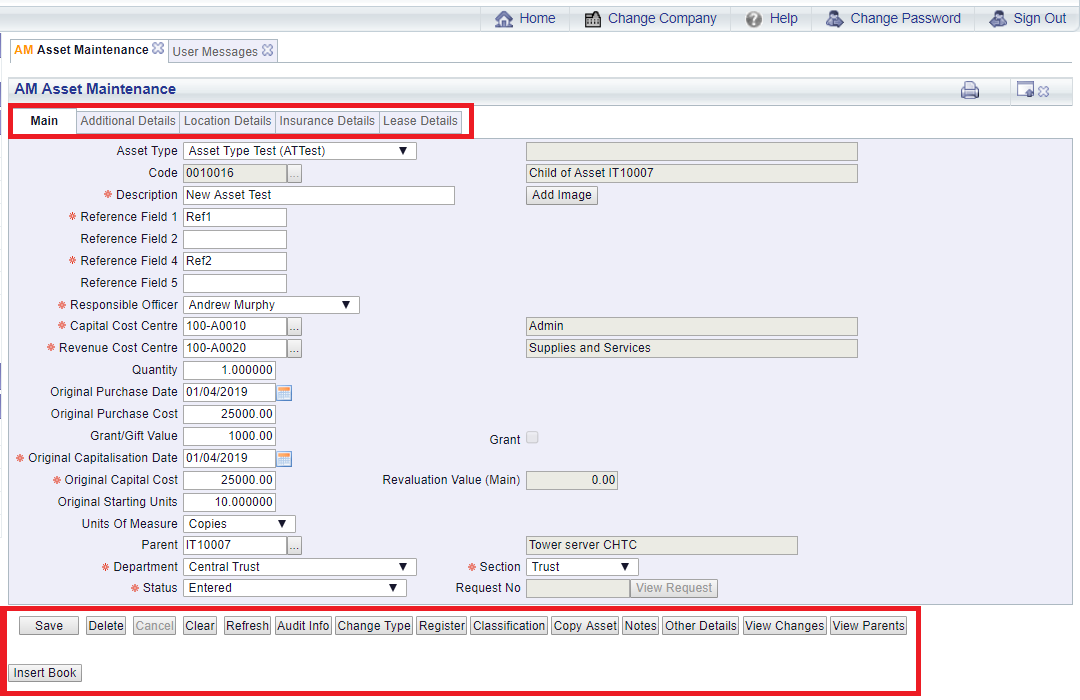
The Status of the Asset will change to  as the Asset has now been created. Please note that it will not yet be available for use as it is firstly has to be registered. Registration is further detailed in the Main tab section.
as the Asset has now been created. Please note that it will not yet be available for use as it is firstly has to be registered. Registration is further detailed in the Main tab section.
The tabs on the AM Asset Maintenance form are as follows:





![]() button.
button.

 : Clicking on this button will allow you to add an image of the Asset from your network.
: Clicking on this button will allow you to add an image of the Asset from your network.
 button and select the required image from your network - the name of the mage will then be added next to the
button and select the required image from your network - the name of the mage will then be added next to the  button.
button. button - the types of files that can be uploaded are listed next to the
button - the types of files that can be uploaded are listed next to the  button.
button. . This will open the AM Find Balance Sheet Cost Centres for the Capital Cost form where the required Cost Centre can be searched for and once selected will be added to this field. This form is further detailed in the Find Balance Sheet Cost Centre section.
. This will open the AM Find Balance Sheet Cost Centres for the Capital Cost form where the required Cost Centre can be searched for and once selected will be added to this field. This form is further detailed in the Find Balance Sheet Cost Centre section. . This will open the AM Find Revenue Cost Centres form where the required Cost Centre can be searched for and once selected will be added to this field. This form is further detailed in the Find Revenue Cost Centre section.
. This will open the AM Find Revenue Cost Centres form where the required Cost Centre can be searched for and once selected will be added to this field. This form is further detailed in the Find Revenue Cost Centre section. . This will open the AM Find Asset Parents form where the required Asset can be searched for and once selected will be added to this field. This form is further detailed in the Find Asset Parent section.
. This will open the AM Find Asset Parents form where the required Asset can be searched for and once selected will be added to this field. This form is further detailed in the Find Asset Parent section. as you are entering the details for the Asset. You will not be able to change this field.
as you are entering the details for the Asset. You will not be able to change this field.
 as the Asset has now been created. Please note that it will not yet be available for use as it is firstly has to be registered. Registration is further detailed in the Main tab section.
as the Asset has now been created. Please note that it will not yet be available for use as it is firstly has to be registered. Registration is further detailed in the Main tab section.